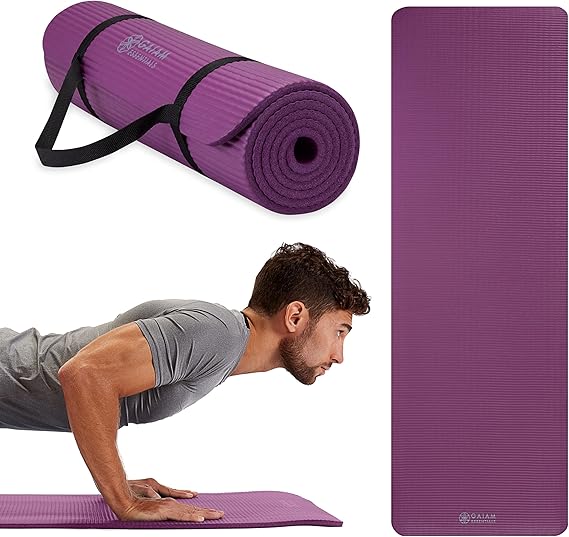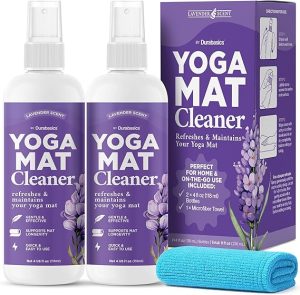When I bought my first yoga mat, I assumed they were all the same—a soft rectangle between me and the floor. I was wrong. The mat that slid out from under me during my first downward dog taught me that choosing the right yoga mat matters.
Your yoga mat is the foundation of your practice. It affects your comfort, balance, grip, and even your motivation to roll it out again the next day. Whether you’re new to yoga or refining your setup for daily practice, this guide will help you understand exactly how to choose a yoga mat—without the confusion.
Let’s find a mat that supports your body, your style, and your goals.

Quick Answer (Skimmable Buying Checklist)
Here’s your quick-reference guide before diving into the details 👇
- Thickness: 4–6 mm for general practice; 1–3 mm for travel; 6–8 mm for knee comfort.
- Grip: Closed-cell = easy to clean; open-cell/textured = better for sweaty hands.
- Material: Rubber (grippy, heavier), TPE (light, balanced), PVC (durable), Cork (natural, better grip with sweat).
- Size: Standard ≈ 183×61 cm; go longer/wider if you’re tall or practice dynamic styles.
- Weight/Portability: ≤1.2 kg for travel; ≥2 kg means extra density and grip.
- Budget: $25–$40 entry, $40–$90 mid-range, $90+ premium.
- Eco/Allergies: Choose latex-free, low-odour, low-VOC options when possible.
Step 1 — Match the Mat to Your Practice
What Style(s) Do You Practice?
Different yoga styles demand different mat features:
- Gentle / Hatha Yoga: Prioritize comfort and cushioning. A 6mm mat with soft density helps your joints relax.
- Vinyasa/Ashtanga: You’ll need a strong grip and durability, as these styles involve intense movement and sweating.
- Hot Yoga: Look for sweat-resistant grip and open-cell texture to prevent slipping.
- Travel Yoga / Commuting: A lightweight, foldable mat (1–2mm) will make life easier.
Where Do You Practice?
- Home floors: Any density works, but thicker mats help if you practice on tile or wood.
- Studios: Mid-weight mats (4–5mm) are easy to carry and store.
- On the go: Foldable travel mats fit in backpacks and are ideal for commuters.
Step 2 — Thickness, Density & Support
Thickness Ranges Explained
- 1–3 mm: Designed for travel and easy portability. Best if you need minimal cushioning.
- 4–6 mm: The all-round sweet spot—perfect balance of comfort and stability.
- 6–8 mm: Excellent joint protection, but can reduce balance precision.
Density vs “Squish”
Not all thick mats are supportive. A dense mat can be thinner but still protect your knees and wrists. Soft, spongy mats may feel nice at first but make standing balance poses harder.
Tip: If your wrists ache during planks, choose a dense rubber mat over a soft foam one.
Alignment & Stability
To test stability, try a Tree Pose. If your mat wobbles or compresses too much, it’s too soft. Dense mats hold firm and maintain balance better.
Step 3 — Grip (Dry & Sweaty Hands)
Surface Texture & Finish
Your grip depends on both material and surface design.
- Smooth surfaces: Great for slower yoga styles; easy to clean.
- Textured or open-cell mats: Offer superior traction when you sweat but may need more care.
- Closed-cell mats: Resist moisture—ideal if you prefer quick cleaning after class.
Hot Yoga & Sweat
If you often sweat, rubber or cork mats perform best. They actually grip better when wet. You can also layer a yoga towel on top for extra traction.
Real-World Grip Test
In Downward Dog or Forearm Plank, if your hands slide forward, the mat fails the test. High-grip surfaces like Liforme or Lululemon mats shine here.
Step 4 — Materials & Sustainability
Common Materials
| Material | Feel & Grip | Eco Impact | Durability | Notes |
| PVC | Smooth, consistent | Low | Very durable | Affordable, not recyclable |
| TPE | Light, elastic | Medium | Moderate | Often recyclable, mild grip |
| Natural Rubber | Firm, excellent grip | High | Long-lasting | Heavy; may contain latex |
| Cork/Jute | Firm, improves with sweat | Very high | Moderate | Natural, antimicrobial |
Allergies & Sensitivities
If you’re sensitive to latex, avoid natural rubber mats unless they’re labelled latex-free. For minimal odour, pick low-VOC certified mats with SGS or REACH compliance.
Eco Considerations
Sustainability isn’t only about material—it’s also about longevity. A durable mat that lasts five years is greener than one replaced every six months. Look for brands offering recycling programs or biodegradable materials.
Step 5 — Size, Weight & Portability
Dimensions
The standard yoga mat size is 183×61 cm. If you’re taller than 6 feet, choose one around 200 cm length or 66 cm width for full coverage.
Weight
Yoga mats range from 0.9 to 2.5 kg. Heavier mats stay stable but are harder to carry. Lightweight mats are convenient but can curl at the edges.
Storage & Travel Tips
- Use a mat strap or carry bag to prevent dirt and creasing.
- For travel, fold your mat with the clean side facing outward.
- Avoid storing in hot cars—it can warp or melt certain materials.
Step 6 — Budget & Value
Price Tiers
| Range | Price (USD) | What You Get |
| Entry Level | $25–$40 | PVC or basic TPE, moderate grip |
| Mid-Range | $40–$90 | Denser foam, better texture, some eco options |
| Premium | $90+ | Exceptional grip, natural materials, warranty |
Warranty & Brand Support
Many high-end brands (like Manduka or Liforme) offer lifetime or extended warranties. That’s a big plus—your mat becomes a one-time investment.
Tip: Calculate “cost per year” rather than upfront cost. A $90 mat lasting 6 years costs less than replacing $30 mats yearly.
Care, Cleaning & Lifespan
Daily Maintenance
Wipe your mat with a gentle water + vinegar solution after each use. Avoid alcohol-based cleaners that dry out the surface.
Deep Clean Schedule
Once a month (or more if you sweat heavily), soak your mat in a mild soap solution, rinse, and air dry flat—never in the sun or washing machine.
When to Replace Your Mat
Replace when:
- The surface peels or flakes
- Grip permanently fades
- Indentations remain after practice Premium mats can last 2–5 years with good care.

Quick Picks by Use Case
| Use Case | Recommended Features |
| Beginners | Mid-thickness, balanced grip, affordable |
| Sweaty/Hot Yoga | Rubber or cork, open-cell texture |
| Travel | ≤1 kg, foldable, compact |
| Eco-Friendly | Natural rubber or cork, SGS-certified |
Comparison Table: Material Overview
| Material | Typical Thickness | Grip (Dry/Wet) | Weight | Pros | Cons | Best For |
| PVC | 4–6 mm | Moderate | 1.8 kg | Durable, low price | Not eco | Beginners |
| TPE | 5 mm | Medium | 1.2 kg | Lightweight, soft | Average grip | Travel users |
| Natural Rubber | 4 mm | Excellent | 2.3 kg | Superior traction | Heavy, latex risk | Hot yoga |
| Cork | 5 mm | Improves when wet | 2.0 kg | Natural, antimicrobial | Less cushion | Eco yogis |
FAQs (Schema-Ready)
What thickness is best for beginners?
A 5–6 mm mat is ideal—it offers enough cushioning for joints while maintaining stability for balance poses.
Are cork yoga mats good for sweaty hands?
Yes. Cork mats become grippier as you sweat, making them perfect for hot yoga or intense practices.
Is 6 mm too thick for balance poses?
Not necessarily. As long as the mat is dense, you can maintain balance without wobbling.
How do I clean a natural rubber mat?
Use a water and mild soap solution or a mat-specific cleaner. Wipe down, then air dry flat in a shaded area.
What size yoga mat do I need if I’m tall?
If you’re taller than 6 feet (183 cm), choose a mat at least 200 cm long to prevent slipping off during stretches.
How long should a yoga mat last?
With regular use and cleaning, most quality mats last 2–5 years before losing grip or cushioning.
Can I use a towel instead of a yoga mat?
A towel can help in emergencies, but lacks grip and stability. Always use a mat for safety and posture alignment.
Final Checklist (Printable)
- ☐ Practice style (Hatha, Vinyasa, Hot, Travel)
- ☐ Thickness & density (4–6 mm standard)
- ☐ Grip (dry/sweaty needs)
- ☐ Material & allergy concerns
- ☐ Size & weight for portability
- ☐ Budget & warranty coverage
- ☐ Cleaning and care plan
Conclusion
Choosing a yoga mat isn’t just about colour or brand—it’s about how it feels beneath you during practice. Your mat should ground you, protect your joints, and inspire you to return to the mat day after day.
If you practice a mix of yoga styles, aim for a mid-density, grippy rubber mat for all-around use. Hot yoga enthusiasts may love cork or open-cell rubber, while travelers should go for lightweight TPE or foldable options.
Remember: the right mat supports not only your poses but also your journey. Take your time, test what feels good, and let your mat become the space where your practice truly begins.
🖼️
“Lightweight foldable travel yoga mat”
“Yoga mat cleaning with vinegar and water solution”
